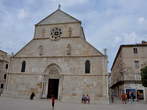The production of salt brought great wealth to Pag, but also problems. Due to salt, the people of Pazan fought many battles in the past, but they also lived comfortably on this account. The tradition of salt extraction dates back to the first settlements in this area.
On Pag, around 33,000 tons of salt are produced per year, and the pools for the preparation of brine, or sea with a high level of salinity, cover an area of more than two million square meters. Climatic and geomorphological conditions contributed the most to the development of salt production in Pag. The salt pools are located in the southern part of the Bay of Pag in a natural shoal in which the current of the sea is very weak. The bottom of the pool is covered with natural impermeable floors or slabs, which, with the constant wind that blows in the summer and spring months, create ideal conditions for the rapid evaporation of the sea and the accumulation of salt. In addition, the fact that there is no abundant and heavy rainfall in Pag is also an advantage. In the past, salt was collected in pools by shoveling it into heaps. It was then loaded onto wagonettes, which were part of the composition of a small freight train that delivered salt to the warehouse. Before wagonettes were used, salt was brought in by sailing ships and pennies (small cargo ships).
With the development of modern technology at the end of the 20th century, the old way of extracting salt was abandoned. After the modernization of the Solina Pag plant, salt is obtained by heating seawater. The pools now have only a monumental significance.
Photos
![Pag Salt Pans - Pag Island - Pag Salt Pans Pag Salt Pans - Pag Island - Pag Salt Pans]()
Pag Island - Pag Salt Pans
![Pag Salt Pans - Pag Island - Pag Salt Pans Pag Salt Pans - Pag Island - Pag Salt Pans]()
Pag Island - Pag Salt Pans
![Pag Salt Pans - Pag Island - Pag Salt Pans Pag Salt Pans - Pag Island - Pag Salt Pans]()
Pag Island - Pag Salt Pans
![Pag Salt Pans - Pag Island - Pag Salt Pans Pag Salt Pans - Pag Island - Pag Salt Pans]()
Pag Island - Pag Salt Pans
![Pag Salt Pans - Pag Island - Pag Salt Pans Pag Salt Pans - Pag Island - Pag Salt Pans]()
Pag Island - Pag Salt Pans
![Pag Salt Pans - Pag Island - Pag Salt Pans Pag Salt Pans - Pag Island - Pag Salt Pans]()
Pag Island - Pag Salt Pans
![Pag Salt Pans - Pag Island - Pag Salt Pans Pag Salt Pans - Pag Island - Pag Salt Pans]()
Pag Island - Pag Salt Pans
![Pag Salt Pans - Pag Island - Pag Salt Pans Pag Salt Pans - Pag Island - Pag Salt Pans]()
Pag Island - Pag Salt Pans
![Pag Salt Pans - Pag Island - Pag Salt Pans Pag Salt Pans - Pag Island - Pag Salt Pans]()
Pag Island - Pag Salt Pans
![Pag Salt Pans - Pag Island - Pag Salt Pans Pag Salt Pans - Pag Island - Pag Salt Pans]()
Pag Island - Pag Salt Pans
![Pag Salt Pans - Pag Island - Pag Salt Pans Pag Salt Pans - Pag Island - Pag Salt Pans]()
Pag Island - Pag Salt Pans
![Pag Salt Pans - Pag Island - Pag Salt Pans Pag Salt Pans - Pag Island - Pag Salt Pans]()
Pag Island - Pag Salt Pans
![Pag Salt Pans - Pag Island - Pag Salt Pans Pag Salt Pans - Pag Island - Pag Salt Pans]()
Pag Island - Pag Salt Pans
![Pag Salt Pans - Pag Island - Pag Salt Pans Pag Salt Pans - Pag Island - Pag Salt Pans]()
Pag Island - Pag Salt Pans
![Pag Salt Pans - Pag Island - Pag Salt Pans Pag Salt Pans - Pag Island - Pag Salt Pans]()
Pag Island - Pag Salt Pans
![Pag Salt Pans - Pag Island - Pag Salt Pans Pag Salt Pans - Pag Island - Pag Salt Pans]()
Pag Island - Pag Salt Pans
![Pag Salt Pans - Pag Island - Pag Salt Pans Pag Salt Pans - Pag Island - Pag Salt Pans]()
Pag Island - Pag Salt Pans
![Pag Salt Pans - Pag Island - Pag Salt Pans Pag Salt Pans - Pag Island - Pag Salt Pans]()
Pag Island - Pag Salt Pans













